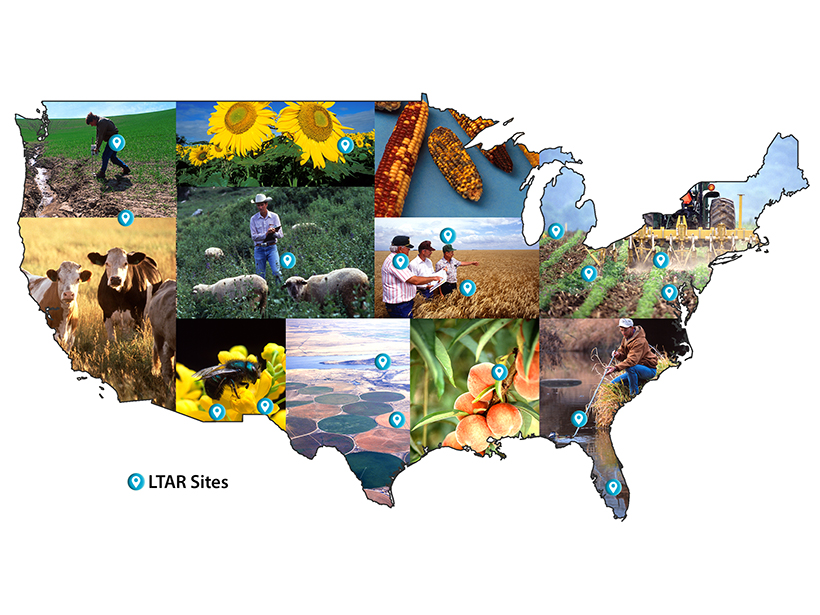Providing a safe and plentiful food supply for a growing population poses a critical challenge to agriculture in the United States and around the globe. In the face of challenges that include population increase, changing climate, excess nutrients, and invasive species, the world will need more productive, sustainable, and profitable farming systems. These farming systems must meet future societal needs, as well as maintain biodiversity, mitigate or adapt to climate change, and improve the quality of air, soil, and water.
Farming systems must meet future societal needs, as well as maintain biodiversity, mitigate or adapt to climate change, and improve the quality of air, soil, and water.
In 2013, the U.S. Department of Agriculture (USDA) established the Long-Term Agroecosystem Research (LTAR) network. This network consists of 16 Agriculture Research Service (ARS) and 2 non-ARS sites located in distinctive hydroclimatic environments. It responds to and prepares for these agricultural challenges and enables long-term, transdisciplinary science across farm resource regions in the conterminous United States.
A group of more than 80 scientists from the LTAR network convened at Florida’s Archbold Biological Station in February 2016 for the network’s third annual meeting. Attendees came to discuss and propose near-term analyses, core experiments, measurement protocols, data archival, and instrument specifications for the network sites. They had expertise in water, climate, soil, crops, remote sensing, ecology, biogeochemistry, and soil microbiology.
The various working groups provided briefing updates at plenary sessions, and breakout group sessions allowed participants to discuss the status of the network’s ongoing efforts and revise measurement and experiment plans for future research. The meeting also included field visits to Archbold’s MacArthur Agro-ecology Research Center and to the nearby University of Florida Range Cattle Research and Education Center.
The participants developed guidelines and selected statistical procedures to compare energetic and economic agroecosystem performance of a common experiment with two scenarios: business as usual and aspirational. The business-as-usual scenario is designed to provide baseline conditions for current production systems and management strategies. In contrast, the aspirational scenario seeks more sustainable agriculture while increasing production and reducing costs and on- and off-site environmental impacts.
Discussions on this common experiment included the size and number of experiment replicates, starting dates of experiments, instruments needed, sensor calibration, and data transfer. In addition, breakout discussions produced recommendations on how to make future observations from such experiments and from the LTAR network in general available on the Web, what common formats to use, what temporal aggregation to apply, and what quality control and quality assurance workflow to implement.
What approach is best to characterize current and future conditions across agroecosystems that vary from rangelands to croplands?
One major question emerged from the meeting discussions: What approach is best to characterize current and future conditions across agroecosystems that vary from rangelands to croplands? Although site-specific needs prevented participants from reaching complete agreement, attendees recognized that the participating scientists had to agree on protocols for analyses in order to obtain consistent multiscale assessments and to allow intersite comparisons.
The participants identified several next steps. One was establishing a collaborative internet portal to share ideas and to foster continued dialogue. Another was starting a set of manuscripts to characterize water, carbon, and nutrient cycles; changes in precipitation and runoff; phenology (studying cyclic phenomena) and its link to productivity; and wind erosion across the LTAR network. The next annual LTAR meeting will be held in spring 2017 in El Reno, Okla.
—Eleonora Demaria, David Goodrich, and Philip Heilman, Southwest Watershed Research Center, Agricultural Research Center, U.S. Department of Agriculture, Tucson, Ariz.; email: [email protected]
Citation:
Demaria, E.,Goodrich, D., and Heilman, P. (2016), Preparing to face the future of agriculture in the United States, Eos, 97, https://doi.org/10.1029/2016EO056511. Published on 01 August 2016.
Text not subject to copyright.
Except where otherwise noted, images are subject to copyright. Any reuse without express permission from the copyright owner is prohibited.
Text not subject to copyright.
Except where otherwise noted, images are subject to copyright. Any reuse without express permission from the copyright owner is prohibited.

